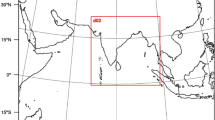Summary
¶Cloud Motion Vector wind (CMV) data is one of the major products derived from current day operational geostationary satellites and continues to be a useful source of information for global data assimilation systems. The CMV fields result basically from the apparent cloud motion estimated through a sequence of very high resolution radiometer (VHRR) images and the corresponding cloud level is inferred from observed brightness temperatures (BT) in the infrared window channel. The main problem in CMV production is associated with the assignment of correct height to the cloud tracked motions in view of the known limitations associated with the cloud emissivity characteristics and estimation of BTs. Despite these inherent uncertainties satellite derived CMVs are widely used to augment the conventional upper air wind data especially over the oceanic regions. In this study, an attempt is made to improve the quality of INSAT derived CMVs through an appropriate height re-assignment by employing first guess fields (short range forecasts) of a global forecast model.
Two experimental height re-assignment methods (EXP-I: Taking first-guess height field into consideration; EXP-II: Taking first-guess height and wind fields into consideration) for correcting assigned heights of CMVs are employed to examine the consistency of the fields. An objective assessment of these reassignment methods is carried out through verification of CMVs against collocated Radiosonde/Rawinsonde (TEMP) and Pilot Balloon (PILOT) wind reports received through Global Telecommunication System (GTS) at New Delhi for a period of 1–21 November, 1996. The collocation statistics clearly show a relative improvement in the quality of CMVs EXP-II. The assimilation-forecast cycle is repeated by subjecting directly derived CMVs to EXP-II method for whole of the above 21-day period and the impact of improved CMVs is examined in terms of objective skill scores (RMSE, Anomaly Correlation Coefficient). The impact of the improved CMVs in the synoptic scales is further examined by conducting assimilation experiments for two typical cases of tropical circulation systems formed over the Bay of Bengal during December 1996 and May 1997, respectively.
Similar content being viewed by others
Author information
Authors and Affiliations
Additional information
Received November 1, 2001; accepted May 8, 2002 Published online: May 8, 2003
Rights and permissions
About this article
Cite this article
Prasad, V., Ramesh, K., Bohra, A. et al. Impact of a consistent height reassignment method for INSAT derived cloud motion vectors. Meteorol Atmos Phys 83, 163–172 (2003). https://doi.org/10.1007/s00703-002-0560-z
Issue Date:
DOI: https://doi.org/10.1007/s00703-002-0560-z




